It’s estimated there are over 400 species of native US bees found in Virginia. Apart from these species, Virginia is the home of many non-native bee species, mainly arrived from Europe.
The following bees are the most common species in the state of Virginia.
Table of Contents
1. Common Eastern Bumble Bee
The Common Eastern Bumble Bee (Bombus impatiens) is one of the most common species in the Eastern US. Highly common in Virginia, the species has increased adaptability and its role as a pollinator.
These bees have a clear hierarchy which can be distinguished by physical size first.
Queen Common Eastern Bumble Bee is the largest. They can grow up to 23mm.

Male bees are second in size. They can grow to a maximum size of 18mm.
Worker bees of the species grow to a maximum size of 16mm.
Aster and Cirsium flowers are among the favorites of these bees. However, the species is well-adapted to living in forests, suburban areas, and even cities.
2. Eastern Carpenter Bee

The Eastern Carpenter Bee (Xylocopa virginica) is a widespread species on the East Coast. This species looks similar to bumble bees, particularly in size.
It can be identified by its mostly black glossy body. These bees are considered major pollinators and they are seen around all types of flowers and crops.
These bees are highly recognized for their role in crop pollination. Specific merits have been attributed to the Eastern Carpenter’s Bee’s role in pollinating blueberries.
As its name suggests, this is a type of carpenter bee. It nests in pieces of wood but it doesn’t lay eggs on pollen inside the nest as other bees.
Instead, these bees are known for carrying pollen to the nest every day to feed larvae and newly-emerged bees.
3. Western Honey Bee
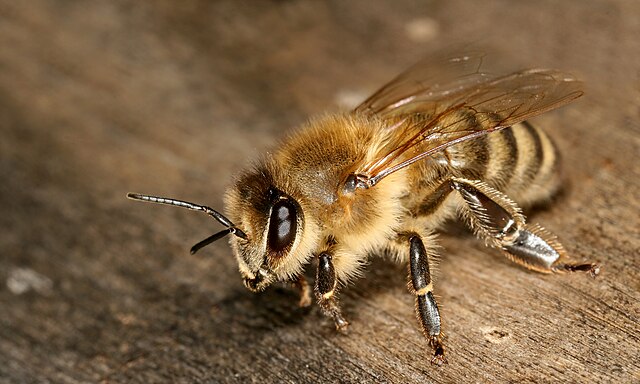
The Western Honey Bee (Apis mellifera) is the most common honey-producing species in Virginia. Its expanded habitat through the US makes it one of the most important domesticated bee species in the country.
Western Honey Bees have a few distinct traits that make them a top species for beekeepers. For example, the bees aren’t aggressive and they can be easily controlled with smoke.
The species is also known for making large amounts of honey.
The honey of the Western Honey Bee is a mixture of sugars with many health benefits such as antimicrobial action, particularly against Staphylococcus aureus bacteria.
These bees are also popular due to their resilience. Most Western Honey Bees don’t get sick easily and they can survive cold weather.
Another key aspect of the species is given by its ability to go long periods without food, even if it consumes honey.
Without the tendency to live in a swarm, these bees have been successfully domesticated for their pollination role. It’s believed its pollination benefits surpass its honey-making benefits.
4. Brown-belted Bumble Bee

Highly common on the Eastern Coast, the Brown-belted Bumble Bee (Bombus griseocollis) is one of the most common species in Virginia. Its habitat expands North even to Canada.
This common bumble bee is known for nesting underground or on the ground. It lives in groups but it may not be a eusocial species all the time as it can also live alone.
Like all other common species in Virginia, the Brown-belted Bumble Bee has very good environment adaptability.
It’s found both in crops, meadows, suburban, and urban areas.
This high adaptability makes the species one of the few that isn’t seeing a decrease in population in the country. Its numbers are rising in certain areas.
Specific roles are always well-established when the bee lives in groups. Its small groups are all centered around the queen.
Worker bees are responsible for keeping up the nest in good condition. Wax and honey are mostly carried by this group.
Male bees have the sole task of inseminating the queen.
It’s expected this species becomes even more popular as it doesn’t have any serious natural threats.
5. Pure Green-Sweat Bee

The Pure Green-Sweat Bee (Augochlora pura) is the first common species in Virginia to have a high level of aggression. This is mostly tied to nesting habits.
Bees of these species nest alone. They dig up nests in the ground where they lay eggs. These nests can then be occupied while the bee is collecting nectar.
Upon its return, the bee can find its nest occupied by another Pure Green-Sweat Bee.
In this case, the owner of the nest uses its strength to pull put the occupying bee.
This aggressive behavior is believed to be tied to an innate ability to care for eggs and larva.
Bees of these species only lay eggs on a ball of nectar which is used as food for the emerging bee.
The pollination role of this species is considerable. Most recent data suggests it has a vast pollination role in forests as it tends to visit more than 20 flowers to collect pollen from.
6. Two-spotted Bumble Bee

The common Two-spotted Bumble Bee (Bombus bimaculatus) is sometimes confused with another popular species in Virginia, the Common Eastern Bumble Bee.
However, the Two-Spotted Bumble Bee has 2 yellow spots on its abdomen.
The common look of this bee is also subject to mimicking tactics of other species.
Known as Batesian mimics, these mimicry tactics are adopted by robber flies and deer bot flies, among other insects.
Still, these bees have an important pollination role in temperate climate forests.
Their resilience in temperate climate allows them to forage even on days with bad weather, something many bees cannot do.
Some data suggest the species is subject to certain troubles such as natural enemies that mimic its looks as well as to parasites.
Nosema bombi is a type of fungi known to affect a large number of bumble bees. While it also affects Two-Spotted Bumble Bees, it’s believed this is without as serious repercussions as to other bumble bees.
7. American Bumble Bee

The American Bumble Bee (Bombus pensylvanicus) is sometimes confused with the most common American bees. However, this name coincidence doesn’t make it the most popular species in the US.
Still, the American Bumble Bee is one of the most common species in Virginia. It faces an uncertain future as its numbers are diminishing, mostly due to a rise in pollution.
It’s also believed the American Bumble Bee suffers from certain diseases brought to be the European Bumble Bee when it was imported in the country as a means to pollinate greenhouse tomatoes.
Today, the American Bumble Bee is still an important pollinator of flowers and vegetables.
These bees live socially. A queen establishes the colonies and lays eggs which then produce the first generation of worker female bees.
Once these bees are mature, the queen doesn’t pollinate anymore as it remains in the nest. Worker bees continue bringing pollen for the newly-emerging generation of bees back in the nest.
8. Two-spotted Longhorn Bee

The Two-spotter Longhorn Bee (Melissodes bimaculatus) is identified by its black color and light markings at the end of its abdomen.
It’s prevalent in parts of the Eastern US, however, it’s one of the species that isn’t studied comprehensively.
Bees of these species are known as excellent pollen collectors. Their bodies are covered with hairs that help carry pollen.
The queen is first responsible for carrying pollen.
It offers pollen to hatched larvae. Whole common in Virginia, these bees aren’t seen as much as others, mainly because they like habitats such as agricultural fields.
9. Bicolored Striped Sweat Bee

These common bees (Agapostemon virescens) are known for their vivid green coloring. They can be seen on a large number of flowers such as false sunflowers, cup plants, and Echinacea flowers.
These are social bees that live in small groups. Unlike other bees, they live in an egalitarian society where females share an underground nest.
Each female cars for personal eggs. Well-adapted to foraging even in the fall, these bees survive cold weather by drinking nectar directly from flowers.
Most Bicolored Striped Sweat Bees are commonly seen in gardens. They live in the ground and they are seen going out and coming into the nest frequently throughout the day.
10. Sculptured Resin Bee

The Sculptured Resin Bee (Megachile sculpturalis) is one of the largest bee species in Virginia. Males can reach a maximum body size of 22mm while females can grow to 25mm.
25mm females are mostly seen in queen-only sizes in other bee species.
This large size doesn’t prevent the bee from being very active. These bees nest in wood but they don’t dig in it.
The species gets its name from its ability to carry naturally-occurring resins. All collected resins are used to fortify their nests.
11. Flat-tailed Leaf-cutter Bee

The Flat-tailed Leaf-cutter Bee (Megachile mendica) is somewhat similar to other leafcutter bees. It has a mostly black body with parallel white lines on its abdomen.
The species is widespread but little is known about its particularities. As a leafcutter, the species is known for using plant fibers to build and maintain its nest.
12. Carpenter-mimic Leafcutter Bee

This is one of the common wide-body bees in Virginia. While highly common, not much is known about this species.
Physical distinctions compared to other carpenter bees are small. While wider and larger than honey bees, the Carpenter-mimic Leafcutter bee is mostly black with black wings.
The species (Megachile xylocopoides) is known for being solitary. Each bee is responsible for its egg and provisioning for emerging larvae.
13. Perplexing Bumble Bee

The Perplexinb Bumble Bee (Bombus perplexus) is also known as the Confusing bumblebee. This is an American native bee species from the Northern parts of the country.
Identification of the species is easier than with other bumble bees. It has a black body covered in pale yellow hair.
This species has a clear hierarchy which is distinguishable by the way the bees look.
Worker bees have more pale yellow hairs than the queen. Male bees are similarly-sized to worker bees.
Preferred habitats of the species include forests and wetlands.
However, the Perplexing Bumble Bee is adapted to human-populated areas. They are often found in suburban areas, particularly in gardens where they feed on flowers and plants.
14. Ligated Furrow Bee

The Ligated Furrow Bee (Halictus ligatus) is identified by its colored hairy yellow body.
Highly active during the summer, the species is known as a general pollinator. It pollinates various plants and flowers via its foragers.
These bees are well-adapted to the environment in Virginia. Various types of nests can be established by this species making it one of the most versatile in the state.
Ligated Furrow Bees can nest both in the ground and rotting pieces of wood.
They prefer to use existing cavities to establish a nest where they will live for a long time or until
bacteria or a parasite appears prompting the bees to leave the nest.
All of the chambers inside the nest are made of irregular shapes. However, they provide a safe space for eggs and larvae which are fed with high protein pollen.
These bees are known for constantly maintaining the nest’s eggs are laid in. A type of wax produced by the bees is used to keep the cells of the nest in good condition and to limit possible fungi spread.
15. Brown-winged Sweat Bee
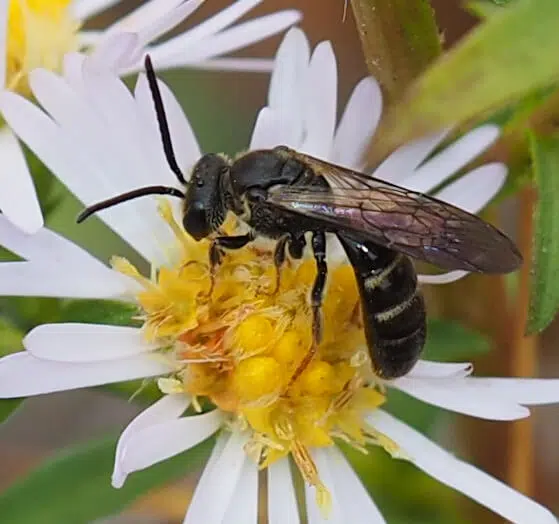
Part of the Lasioglossum genus, the Brown-winged Sweat Bee (Lasioglossum fuscipenne) is recognized by its mostly black body with yellow lines.
Its wings are brown and translucent, similar to most other bees of the genus.
This species is not a selective pollinator. It’s known to consume the pollen of various plants and flowers
16. Asian Shaggy Digger Bee
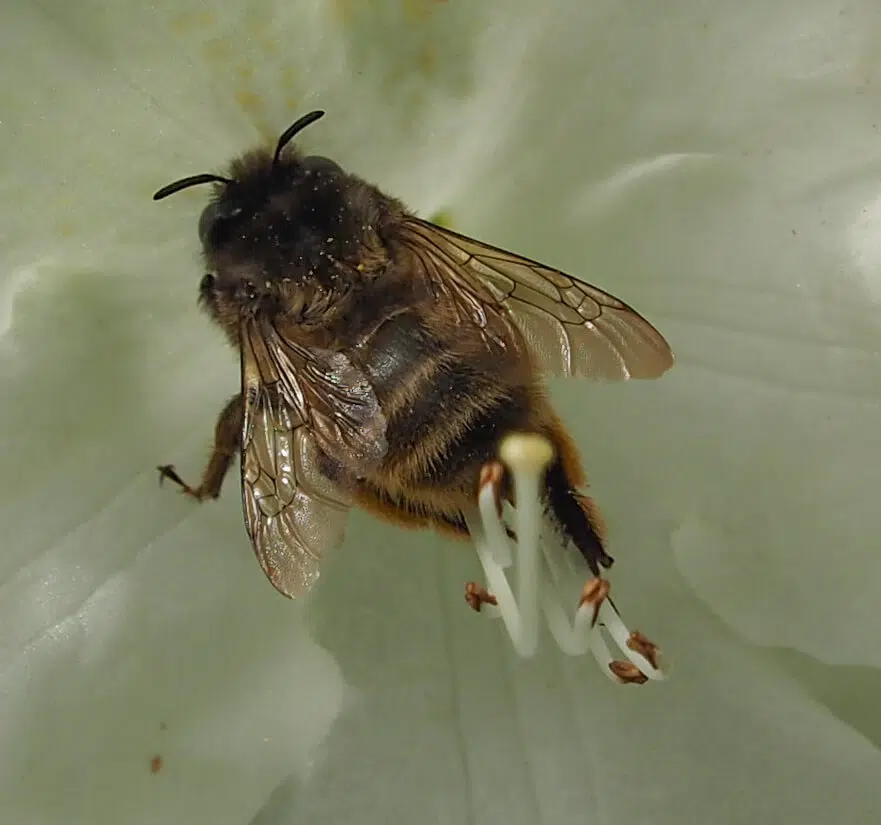
The Asian Shaggy Digger Bee (Anthophora villosula) is one of the species introduced to the US with exponential growth. It’s common in most regions which include Virginia.
These bees are known for their thick body which is strong enough to dig in the ground.
Common habitats for this bee include sandy terrains which are easy to dig in. These bees commonly nest around Azaleas.
17. European Woolcarder Bee
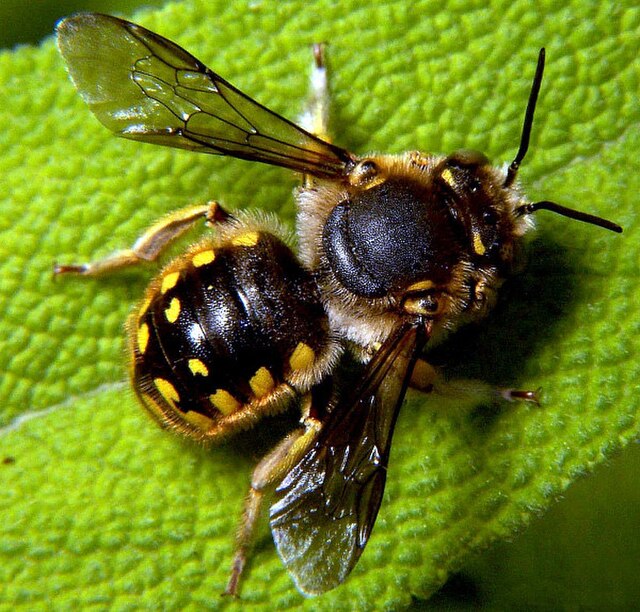
The European Woolcarder Bee (Anthidium manicatum) is a species introduced to the US from Europe, as its name suggests.
It was first seen in New York. Since then, it has spread to most parts of the Eastern US.
The bee is identified by a wide body with black and yellow coloring.
Females of the species are smaller than males as they only grow to 13mm while males grow to 17mm.
These bees are known as generalist pollinators as they don’t exhibit any preferences for certain flowers. It’s only in the case of abundant flowers that these bees prefer blue flowers.
Bees of the European Woolcarder Bee are also known for collecting flower fibers which are used to build and maintain their nests.
18. Black-and-gold Bumble Bee
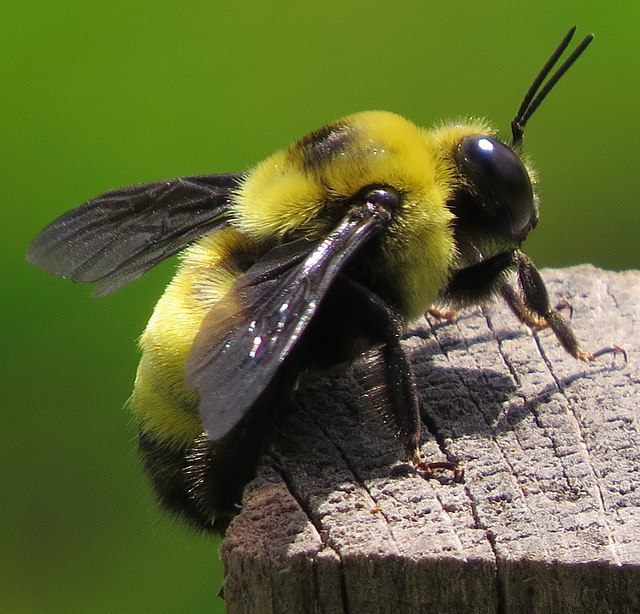
This species (Bombus auricomus) is native to the Northern parts of the US. It’s mostly a black bee but its multiple pale yellow hairs cover most of its body.
The species is known to nest both in the ground and above the ground.
Like many types of bumble bees, it collects nectar from many types of flowers. Preferences include thistles, clovers, and teasels.
The species can be further categorized as average-size compared to other Virginia species. It grows to an adult size between 0.3 and 0.5 inches.
Queens are larger. They grow up to 0.75 inches.
19. Metallic Epauletted-Sweat Bee

As its name implies, this bee (Augochloropsis metallica) is identified by a green metallic body. Its wings are transparent while its antennae are black.
This species nests in the ground. It’s believed its numbers are declining due to a diminishing ecosystem of flowers.
The Metallic Epauletted-Sweat Bee is one of the multiple green metallic bees in Virginia. This is why the species is often confused with the Pure Green Sweat Bee and the Striped Sweat Bee.
20. Hibiscus Turret Bee
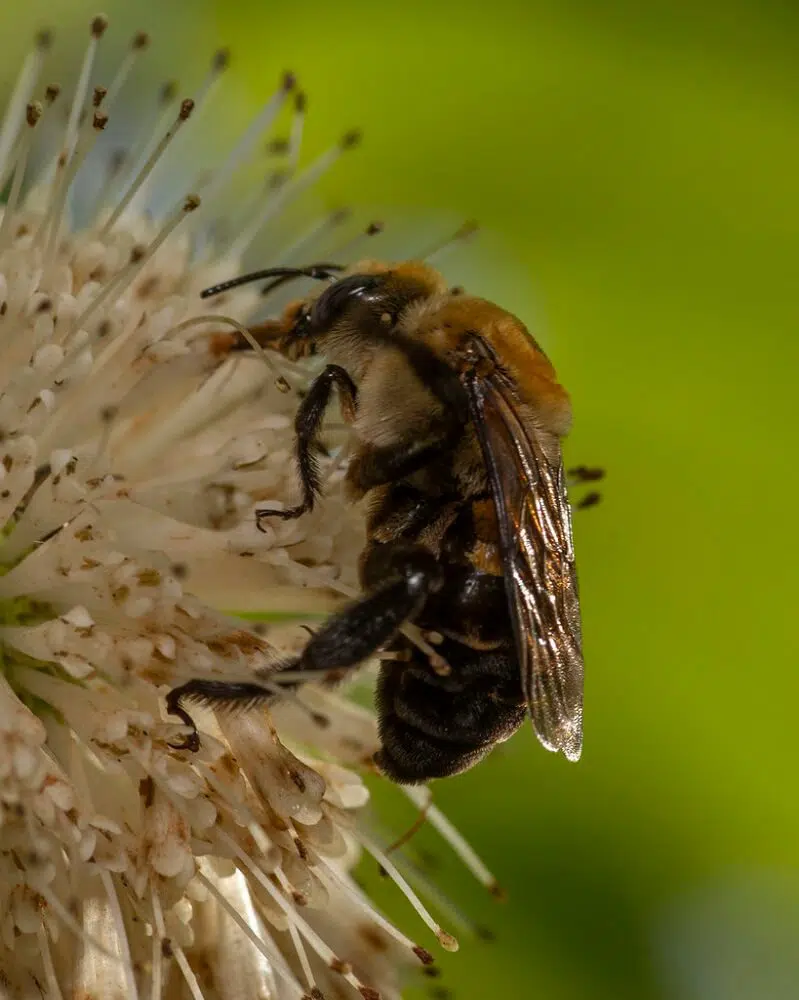
This is a species of solitary bee. It nests in the ground where it can live entirely on its own.
The Hibiscus Turret Bee (Ptilothrix bombiformis) is not known as an efficient pollinator.
Females of the species are responsible for building nets. Female Hibiscus Turret Bees are also responsible for defending the nests.
Some females of the species have been seen even abandoning an underground nest if a parasite such as fungi is found inside. They also defend the nest from possible intruders by covering up the entrance.
21. Golden Sweat Bee

The Golden Sweat Bee (Augochlorella aurata) is attracted by human sweat. This species can be identified based on its vivid coloring.
Golden Sweat Bees are one of the multiple metallic green bees found in Virginia.
Its body size is smaller compared to all other green metallic bees of the state as it barely grows to 7mm when it reaches adulthood.
The bee is known to populate a vast part of the Eastern coast outside Virginia up to Canada.
22. Oblong Woolcarder Bee

This yellow and black species is known to live close to man-made buildings. It uses crevices in walls to build nests.
The species isn’t a Virginia native as it’s found on multiple continents. However, these bees (Anthidium oblongatum) are known for their good abilities to adapt to urban environments.
Often seen around homes and gardens, the bees don’t need to find a nest close to their favorite flowers. Oblong Woolcarder bees can travel long distances from the nest to the flowers it visits.
23. Confusing Furrow Bee

These bees (Halictus confusus) are known to be partially green. The thorax has a metallic green color while the abdomen is black with white lines.
The Confusing Furrow Bee is one of the few species in Virginia that nests in the ground where the entrance to the nest is horizontal and not vertical.
It’s believed this is the first form of defense for the nest even if Confusing Furrow Bees are also known to guard the entrance to their nests.
Multiple species see the Confusing Furrow Bee as prey.
Crab spiders are known to be one of the predators of these bees. Ripiphorus walshi larval parasites are also commonly found in the nest of these bees.
24. Spring Beauty Miner

Spring Beauty Miner bees (Andrena erigeniae) are native to North America. These bees are commonly seen through Virginia gardens in the spring and early summer.
The bees collect pollen by a very strict schedule, particularly before noon.
Pollen makes its way with bees at around 10 AM first through the day while the remaining bees collecting pollen are back at the nest around noon.
Pollen is used to feed larvae.
Both male and female Spring Beauty Miner bees are known to emerge at the same time in the spring.
25. Lunate Longhorn-Cuckoo

The Lunate Longhorn-Cuckoo bees (Triepeolus lunatus) are a species of cleptoparasites bees.
Most Lunate Longhorn-Cuckoo bees live in the vicinity of forests.
These bees can be identified by black and white coloring. Their bodies are black with white lines on the abdomen and white marks on the thorax.
26. Golden Northern Bumble Bee

The species (Bombus fervidus) is identified by its black and gold color. These colorful bees are mostly seen in the afternoon as they prefer to forage in the hottest weather.
Nectar is their preferred food source.
Golden Northern Bumble Bees live in small colonies. These bees are dominated by a queen.
However, the queen can sometimes enter into conflict with other female bees.
Worker female bees can lay eggs that are not fertilized. These eggs are known to produce male bees.
27. Unequal Cellophane Bee
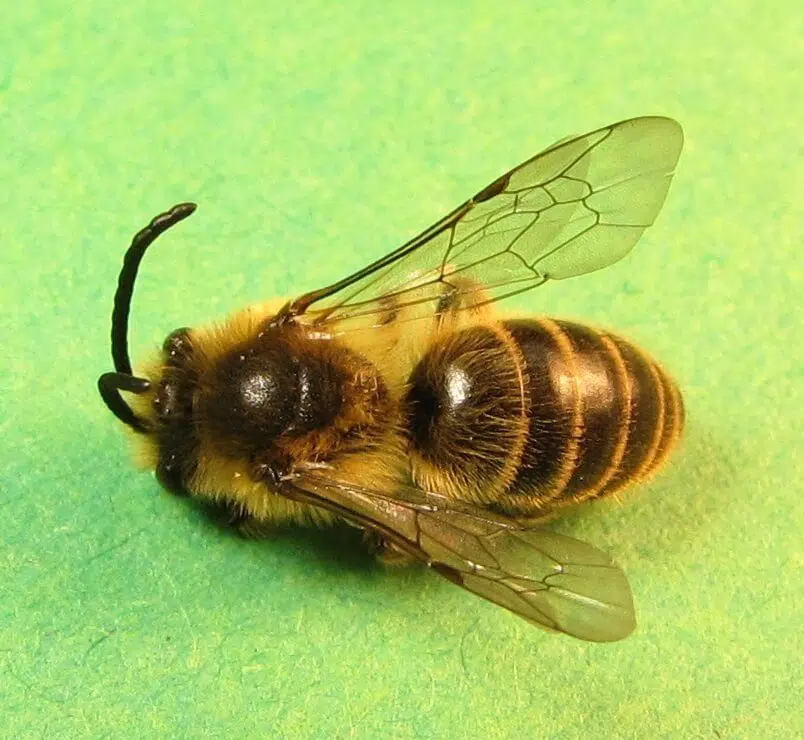
The Unequal Cellophane Bee (Colletes inaequalis) is commonly seen around maple trees and willows. These bees emerge in March and they multiply quickly.
Unequal Cellophane Bees are known for their ability to dig in the ground.
The nest in the ground with a preference for grounds that get more sun exposure in the afternoon.
Underground nests are commonly found under maple or willow trees. It’s only the females that are seen in these nests during the day as males are commonly found outside on patrol.
These bees are adapted to living next to homes as they’re often found in suburban areas.
The Unequal Cellophane bees are common in backyards, gardens, and parks.
Further Reading: